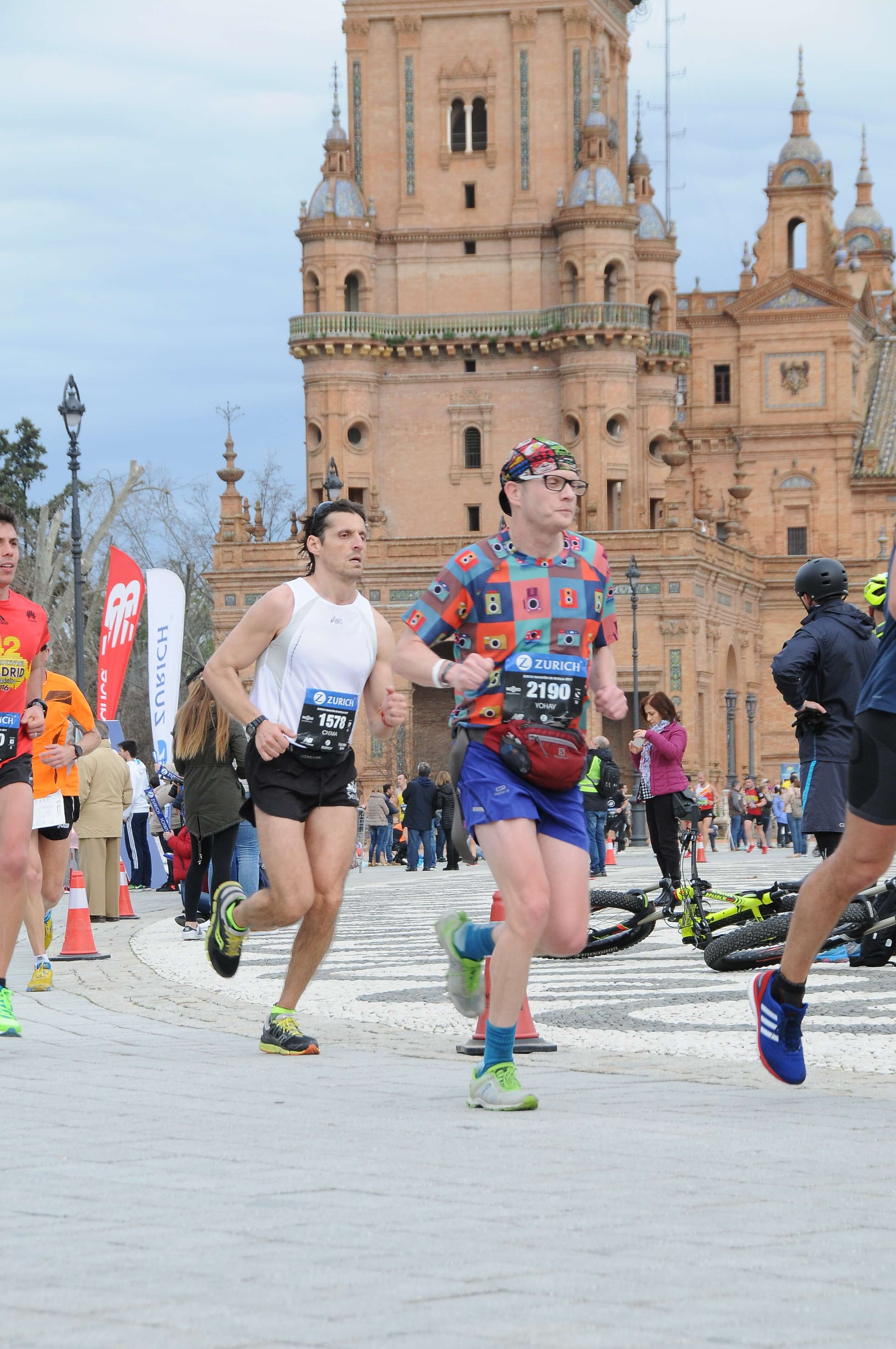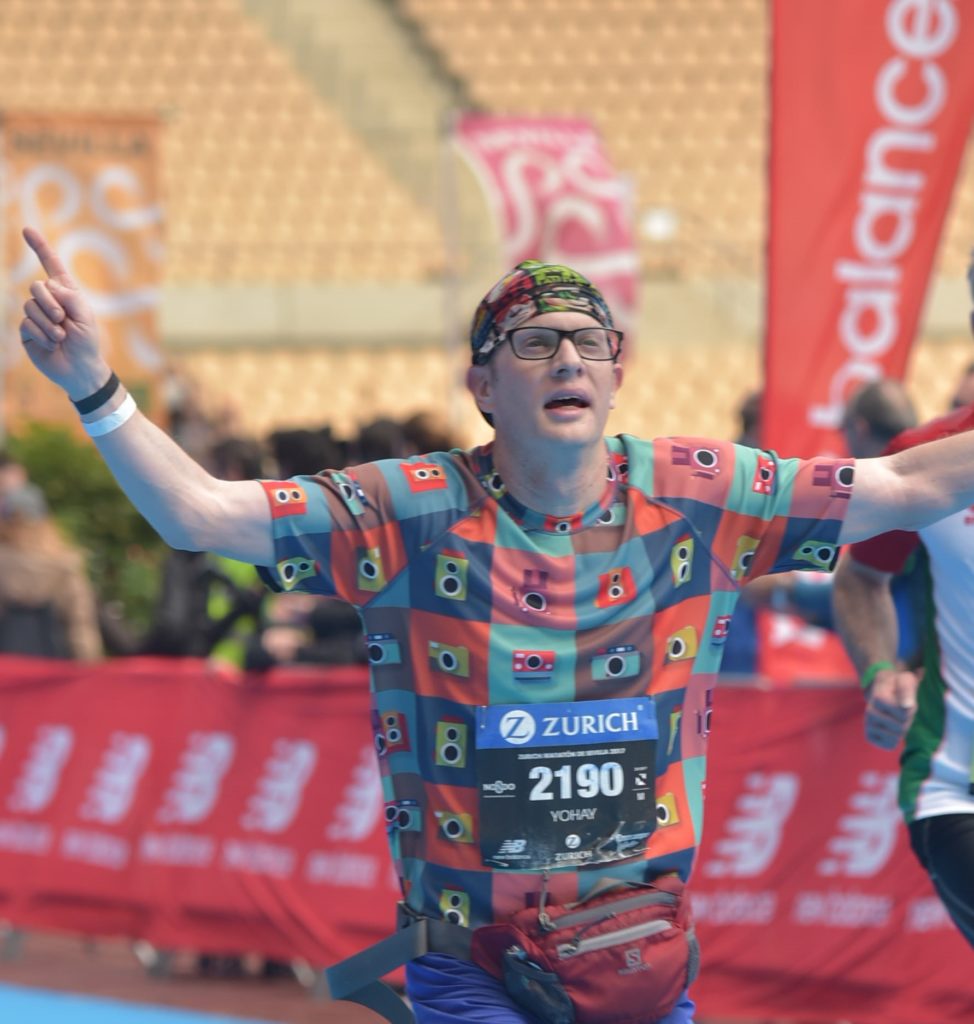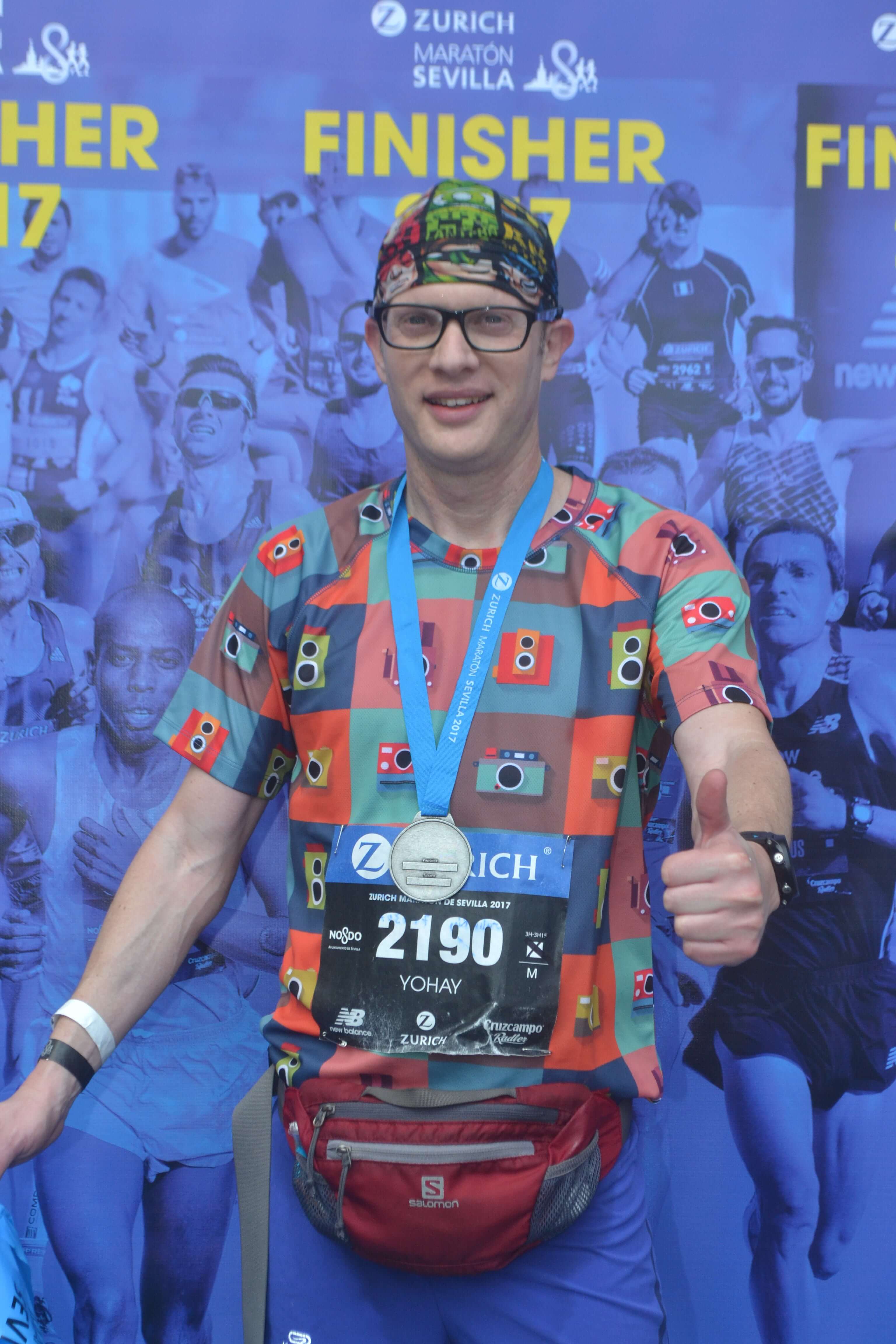Running the Seville Marathon in 3 hours – the full race report
Published : 02/23/2018 12:25:29
Categories : All , Races

Today`s post was written by Yohay Elam about his experience in 2017 Seville Marathon running with a Hoopoe Running shirt. Thank you Yohay!
Last minute to the first mile
The clock strikes 5:00 and the alarm clock startles me. It’s race day, and I am fully awake after a weird dream. Intense dream = intense sleep, so that’s a good start. Check.
After my usual breakfast and my usual overindulgence of coffee, I paid a visit to the bathroom. Check.
My parents (which accompany me to every marathon since that miserable near-death experience following my first marathon) and I step out the door at 7:00. It’s still dark in Seville, and the weather is cold and fresh. I keep on munching on more light carbs and sip some isotonic drink, waiting for the taxi that I had reserved two days in advance.
But there’s no cab. Repetitive calls to the taxi station result in a busy line, and we decide to try heading towards the Giralda. Fellow runners also seem befuddled. The clock continues ticking, and we find ourselves in a herd of runners heading towards a bus station by the river, and that is my Plan B. Plan C involved just running some 4K to the starting line.
Luckily the bus comes, and we get on by the back door. We never paid. Sorry Seville. We owe you 5€. Getting off the bus, I was very lucky to have my parents with me: we decided not to go the stadium and leave the stuff but rather approach the starting line.
I managed to squeeze in a very light 1K warm-up, falling short of my usual 2.4K (1.5mi) one. While I was re-retying my shoelaces just before the entrance to my running corral, my father directed my attention to the fact that the runners were on the move. A quick selfie and I joined in, basically chugging along the 3:15-3:30 group instead of my 3:00-3:15 one.
And here we go!
8:30: Four months and it’s time to cash in. I felt the excitement crossing the start line hitting Go on my watch.
Following the sound advice of Aurelian (Strava), I adopted the Hansons’ Marathon Method plan. The training program focuses on maximizing performance on race day and discourages races along the way. While I didn’t fully adhere to that guidance, I basically followed the plan by a ratio of 90%. So now it’s money time.
I sifted through the other runner to complete the first kilometer at 4:32, significantly slower than the magical number of 4:15 needed to hit the 3-hour mark.
During my marathon pace tempo runs on Thursdays I reached 4:10 once and my last run saw 4:15. However, as this was my first experience with the program, I was telling everybody that I could run around 4:20 min/Kwhich is a marathon in around 3:03, a more conservative approach.
Apart from running crisscrossing slower runners, I guess I needed time to warm up after that rush to the start. The body needs the first few minutes to ease into the aerobic mode, so I wasn’t worried.
I picked up my pace and managed to compensate for the first kilometers gradually. Crossing the Triana bridge and passing by the Torre de Oro was rewarding. The crowds cheered and I was feeling good.
Seconds in a bottle
The first aid station appeared to my left, and I ran towards it. Being right-handed, I feel more comfortable picking up things on the right-hand side. Well, a few meters on, there was a stop on the right as well. I actually read that water would be available on both sides in the manual. OK, this won’t happen again – next time I’m only sticking to the right.
The water was handed out in paper glasses rather than bottles. This is great for the environment, but I’m not used to it and found myself using two hands to pick up the glass. A fellow runner explained (in English of course) the best practice in taking the glass and sipping off the water. I thanked him, but I must say this skill still lacks perfection.
Throughout the race, I stopped at almost every aid station to pick up some sweet Aquarius or wash up the gels with water, and I felt it slowed me down. I used to ignore complaints about glasses and praises for bottles, butI guess that getting a grip on a bottle is time-efficient.
Fueling – just do it
After a few kilometers in the race, I felt a very mild sense of hunger. After having my usual cereal and yogurt breakfast, I kept on chewing on quite a few energy bars and a banana. Apparently, another small something was amiss, and I pulled out my spare energy bar very early in the race. Better push those calories in. Bar eaten, problem solved.
Around 9K into the race, it was time for the first sports gel, executing my game plan of a gel every nine kilometers. I pulled one out of my pouch, and it wasn’t the one I imagined to see. It was another one I was familiar with, but not the one I intended to consume on race.
What’s going on? I pulled out another one, and it was the same, wrong one. Oops, I probably bought the wrong package. How could I miss that with all the planning? I signed up to the race ten months in advance, begin reading the training book six months in advance and started the program on time.
Instead of diving into the mire of self-pity, I just took it in. And I decided I’m going to like it. The show must go on. The gel didn’t taste like I wanted it to taste (makes sense when it’s the wrong one), but it was A-OK. It also did the work of energizing me. Next time, double-check that as well.

Mid-race at max racing
After 14K I was stable, going at a good pace and having mostly compensated for the lost seconds early on without burning myself. My wife Galia and my parents waited for me at the Macarena Church by the walls, and that gave me a boost.
Things got better from there on: while the views weren’t that exciting (Avenida Kansas City seemed neverending), the temperatures dropped (at least that’s what I felt) and looking at my watch, my heart rate ticked down, a sign I was doing great.
I crossed the half-marathon mark at 1.29:48, close to my half-marathon race two weeks before the big day and set to tackle the 3-hour mark.
But maybe I felt too great and also greedy. I ran at a pace under 4:10 until the 25K mark. I felt that I could pick up my speed after having cruised through the first half.
If I were to run a negative split race, the halfway mark was the place to hit the pedal, right?
Wrong. In hindsight, I know the right place to push is somewhere after “the wall,” with less than 10K to go. Another lesson for the next time.
I slowed down to 4:22 in the 26th kilometer but and never ran under 4:10. I managed to stabilize around 4:15-4:17 for a few more kilometers.
Struggle sí, wall no
Around the 34th kilometer, we entered the long stretch of Avenida de La Palmera. The wind became stronger and was slowing me down. At least they cooled down my legs, which were on fire. A light burning sensation crept in the bottom of my feet. New blisters were being formed, and I could follow every phase.
I wasn’t the only one slowing down. Others were also suffering from the wind and/or hitting the wall. I can blame the wind and can blame my greed, but I could not blame the wall. Looking at the data, 4:13 in the 33rd K, 4:17 in the 34th, 4:27 in the 35th and 4:20 in the 36th is no wall.
The program emphasizes that you learn to run on tired legs and the longest long run of 16 miles simulates the last 16 rather than the first ones. So here I was, in the middle of the last 16 miles, tired but prepared.
During this long stretch of slowing down and facing the wind, I had a dilemma. Bypass the slower runners and confront the wind? Or slow down with them and preserve some energy?
I had no clear answer, just doing a bit of both. I brought forward my gel intake to the 35th kilometer, every bit helps.
What I did do is play three psychological mind-games I had read about:
- Imagine your friends and family cheering you: It sounds stupid, but imagination can do wonders. Just thinking they have your back whatever result you make keeps you pushing on.
- Tell yourself the next aid station is close: This was not that relevant on that cloudy day, as I didn’t yearn for any drinks. I hardly missed any station.
- Sing the songs I heard during the fast workouts: I wasn’t singing out loud, that would waste energy at a critical juncture, but running through some of the tunes that were the soundtrack of my bigger efforts helped.
Crowds come in and near crash
In the 36th kilometer, we left the neverending Avenida behind and entered the Parque Maria Luisa that was to our right most of the way. The change of the views was also accompanied by growing crowds.
Entering the vast Plaza España, the winds had changed, at least temporarily. The round-trip in the square which features a round-trip of Spain’s province in 1929 felt like a victory lap, or at least a powerful second wind.
Can I still run sub 3 hours? Probably not, but I’m going to my best. It’s money time.
Oh, the wind came back as we were heading northbound once again. But the masses were already aplenty: passing via the Avenida Constitución alongside the Giralda and the city hall, I felt empowered even though I could not duck under the 4:20 min/K mark.
Somewhere along the way, while running on some cobblestones in the old city, I misstepped and nearly fell. A rush of pain passed through one of my ankles. These worries didn’t last for more than a few seconds: it was just a small distraction, no sprained ankle. On with the show.
As I entered the Alameda de Hercules (if I run this race again, my hotel will be there, closer to the start line), the pain had totally dissipated, but I the second wind from Plaza España was replaced by stronger wind and accumulated fatigue.
Victory lap

Crossing the Barqueta bridge, the small ascent seemed like a mountain. Nevertheless, I was piercing through and was surprised to discover many had lined up in the last two kilometers, in an area which is not residential to cheer us.
And there was the stadium. Going down into the tunnel I took advantage of the descent to accelerate. Upon entering, the roar of the crowds, including my family, made me forget about shaving off another second or two.
The lap around the track felt victorious, and I used my remaining energy to raise my hands and wave to the people. As aforementioned, I might have a future in politics.
I crossed the finish line and well, after hitting the Stop button, I began clapping my hands.
My watch showed 3:00:34. The sub-3h will wait for next year, and running a 3h marathon is much more than great.
Post Race
After running slowly for a bit, I began walking and shaking my legs, stopping to pose for the camera.
In the tunnel, I grabbed everything I could. Finishing the marathon, I had a license to eat whatever I wanted and at any quantities. And that’s what I did, munching on Doritos while I was changing clothes and downing a jamón sandwich my family had bought me while we were walking back to town.
We continued to lunch at the fabulous Eslava restaurant (thanks, Julia!) before taking going to rest. In the evening, I indulged into Ocumare’s gourmet chocolate and had dinner at conTenedor (thanks, again and again, Julia). All are highly recommended in Seville, with or without running 42.195 kilometers.
More Thanks
Thanks to my family for supporting me. This was my fourth marathon, the first out of Barcelona and the second one in which I succeeded in running a great race. Here is the finish of the previous one, in Barcelona 2015, where I clocked 3:18 alongside my friend David:
Running a rigorous 18-week plan which peaks with a few weeks atop the 100 K/week mark means making some changes to the routine. At least this time was different: I was logging more miles while Galia said it affected her less than the previous challenges. Running long runs only every other weekend instead of each and every one makes a big difference. And it makes more significant difference when these runs are shorter.
So, I am happy with the Hansons’ plan not only for what did happen: a great season with an excellent result but also for what did not occur: less interference with social life and no injuries, touch wood. Increased volume is probably necessary for upping the game, but it comes with an increased risk of injury. And that did not happen. I recently bought the Hansons’ Half Marathon book.
And here’s the opportunity to thank Aurelian again for recommending the plan.
Aurelian also asked some of the smart and less smart questions during the season. Many thanks! He warned me that the high dose of easy runs could bore me out. Well, I found myself listening to tons of podcasts, so I also learned a lot on the way, not only about running but also about many other things, unfortunately too much about American politics…
What’s next?
I went to a pre-planned physiotherapist at Fisioterapia Sevilla Seville in the morning after the race. Alejandro identified my weaker muscles but said I am perfectly fine. He did a good job, and I can recommend him.
I took a full week off running as we toured the south of Spain. The first two days saw some challenging descents of stairs but everything was in the realm of normality, and no damage was done.
Those three hours and the thirty-something seconds passed quite fast. I want more!
Three days after the 2017 Barcelona marathon I already signed up for the 2018 edition, which is the 40th of my city’s race. 51 weeks to go.
Below you can find another view of the rac, more pictures and comments, which are welcome as always.

Congratulations Yohay! Thanks for sharing your experience with us!

Thomas
04/18/2020 07:42:42
Great recap...and great result there. 3:00:34...ooft! I'm planning to run Seville in the coming year so this has been a great primer; especially those cobblestones and the crowds! Thanks, Thomas
Fisioterapia Sevilla
01/30/2020 13:55:46
Great article, congrats!